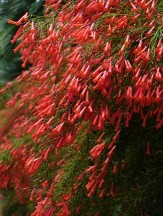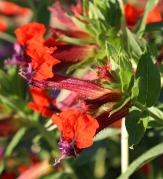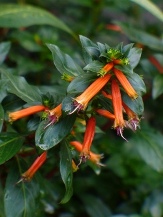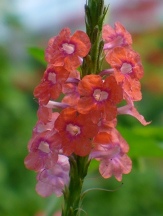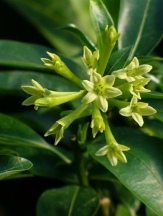Creating A “Once-Mown” Meadow or Prairie for Pollinators
You can easily develop an exceptionally low maintenance, spring-fall flowering, natural wildflower meadow filled with diverse high-quality native plants for pollinators that has one single annual maintenance requirement to keep it healthy and increasing in quality over time – mow it once in winter. We have adapted what would normally require an annual controlled burn using mowing to achieve the same desired effect. Some of the highest quality, most diverse natural meadows and prairies exist along utility line right of ways and railroads where these areas receive the same annual mowing treatment. In nature, our tall grass prairies, conifer forests (Longleaf Pine, Redwood), savannas, and even the acid pitcher plant bogs of the wet and humid southeastern US have come to depend on fire to clear the soil of dead foliage and to prune back existing vegetation. The fire creates a ‘disturbance’ that exposes the soil’s surface to the sunlight that many of these native species need for good germination as well as reducing existing competition. Fire also helps to thin and crack seed coats of some important species and a good mowing machine can have a similar effect. Over a period of just a few years, what may have once been an area of high maintenance monoculture grass or unsightly weeds can become a reliable, high-quality, and long-term source of nectar, pollen, and habitat. A diverse mix of annual, biennial, and perennial forbs (broadleaf herbaceous plants) and graminoids (grass-like plants - grasses, sedges, rushes, etal.) has the potential to support a diverse cast of native pollinators, beneficial insect predators, songbirds, and many other cute and cuddly critters. This is a project that a family, school, or a community can do, enjoy, and learn from together but it is also simple enough to be completed by an individual.
For farmers and anyone else involved in vegetable gardening or fruit production, studies show that the benefits of this type of naturalistic area near production areas far outweigh the costs of developing and maintaining them. Just having a 3 or 4-foot-wide strip of natural wildflower area along one edge of a vegetable garden or orchard has the potential to increase pollination and thus fruit production. It also has the potential to reduce or even eliminate the need for pesticide applications due to the increased diversity and populations of natural predator populations. This growing trend is one of the most cost effective and low maintenance methods for developing an effective and diverse, easily managed, high-quality, long-term pollinator habitat. Not counting labor and yearly maintenance, the average material cost to install a new landscape is between $4-12 per square foot. This means that for a 10'x 100' area you are looking at a minimum of $4000.00. For the same size meadow, you can buy a high-quality wildflower seed mix for $40-$60. If you have a place to collect native seeds from private lands, it may only cost you time.
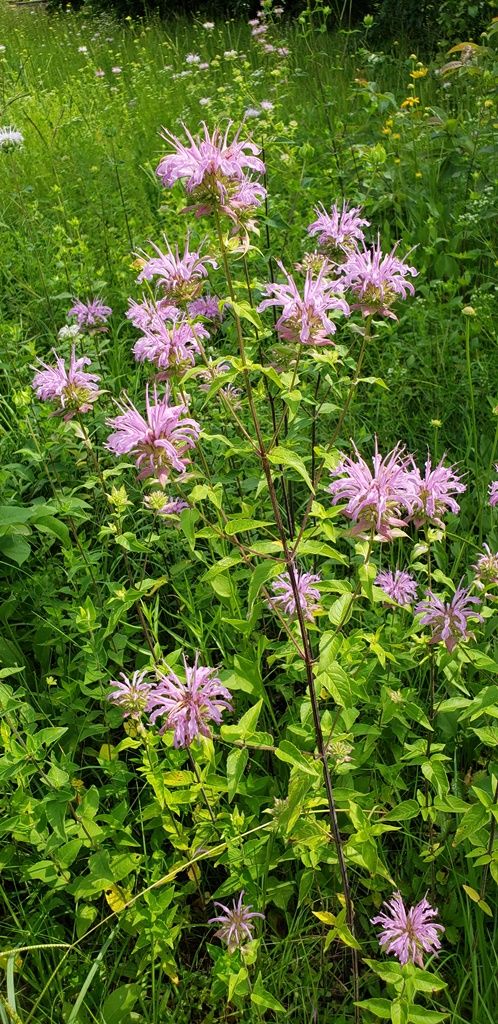
Beebalm, Monarda fistulosa
Step 1. Select a Sunny Area
You can start with an area as large as just a few square feet, select a strip at the edge of your lawn or along a roadside, or you may have acres of land that you would like to develop. This area should receive preferably 8 or more hours of direct sunlight per day for optimum vigor, flowering, and health of meadow and prairie species. Try to locate the meadow or prairie in an area that you can see even if it’s from a distance, so that its seasonal choreograph of pollinators and flowering plants will draw you to it. The area should not be flooded for extended periods of the year on a regular basis, which seems obvious, and you should have the necessary permissions (zoning laws and significant others come to mind here) to develop the area over the long term as you intend to. As long as the area you have selected is currently growing some type of vegetation, such as grasses or weeds, there shouldn’t be any reason that native species will not be able to grow and thrive there also.
Step 2. Get to Know the Area You Intend to Develop
Getting a deeper understanding of what your soil is like, pun intended, will help you to ensure that you select species that are well-adapted and should have no problems establishing and multiplying under your garden’s conditions. What is the soil like – clay, loam, or sand? Is the drainage – average, excellent, poor? Are there areas where water stands for extended periods like a week or more? Is your soil’s pH alkaline, neutral, or acidic? It is not that we intend to change the soil but this will help with selecting species that are optimum for the conditions they will endure.
Step 3. Research – Selecting Your Meadow and Prairie Species
Many of the same species native to prairies can be also be found growing in meadows, glades, savannas, roadsides, and even in and around acid bogs. This overlap reflects the fact that many of these species are widely adaptable to growing conditions helping to further increase our chances of success. It also just happens to help make the seeds of these species more widely available to gardeners.
It may be easiest to start with a general list of species that are recommended for meadows or prairies in your state or ecoregion. We have provided several excellent online resources as starting points in Appendix A, many of which include images of many or most of the species they list. We have provided a list of over 80 species that are in our own once-mown meadows in Appendix B and have denoted species that we could potentially add. This list of over 200 wildflower and grass species also indicates which of those species that are native to both the Tall Grass Prairies and the Coastal or Cajun Prairies to further demonstrate the overlap and the exceptional adaptability of many of these species to climates and soils. Our list does not include the many sedges, rushes, and many of the other often smaller graminoids that exist in our meadows but are also an important part of these ecosystems so don’t be put off by wildflower mixes that contain them or be shy to include them in your own mixes.
You want to find species that will not only thrive in your ecoregion, but there may also be specific plants that you would like to see in your meadow or prairie. While you are doing your research, take the time to make a “Top-Ten List” of plants that you would most like to have and try to include some if not all of them. I personally have a tendency to lean toward the Aster or Composite family and my favorite color is yellow. Coreopsis, Yellow Coneflowers (Rudbeckias – like Black-Eyed Susans), and Sunflowers provide a non-stop showing of bright yellow daisies from early spring, through summer, and often until late November providing bouquets even for Thanksgiving. If you happen to like the purple flowered Blazingstars, a.k.a. Gayfeather or Liatris, an important pollinator plant and many make good quality long-lasting cut flowers, there are over 55 species in the Flora of North America, 12 species in the Flora of Missouri, and 14 listed for Louisiana if you count the individual varieties/subvarieties/forms. There is a Blazingstar species that should work in any meadow or prairie you design and the same can be said about many different types of plants.
It is important to have species that flower in each growing season of the year so that the meadow or prairie can provide a continuous source of nectar and pollen to native pollinators and other beneficial organisms. Some of our 4000 species of solitary native bees have only a short 3-4 weeks from the time they emerge as an adult until they reproduce and die. These specialized pollinators need to have the resources on hand to prepare quality food stores for developing offspring that may not emerge from their nests until the following year. The more diverse your plant species are the more likely that your new garden will be able to support all types of pollinators when they need it most.
Plan to have your seed on hand for early fall sowing whether you collect and prepare them yourself, you intend to purchase them, or use a combination of the two. There are a number of reputable, native wildflower seed sources on the internet who offer diverse selections of species, general and specialized wildflower and prairie mixes, and some will allow you to create your own mix down to the exact percentages of each species. You can start with one of their mixes and enhance it and improve upon it to your liking. Not all species are going to be commercially available and some may not be available every year so keep alternates in mind. It is generally recommended to look for seed sources that harvest seed from your ecoregion. There are numerous seed companies who harvest locally in states across the US but keep in mind that many seed companies source seed from outside of their ecoregion. This is not a requirement, thanks to the adaptability of many of these species, but it may help to further ensure that your plants are optimally suited to their new environment.
You may also want to include transplants of wildflowers that may be especially difficult to establish from seed or are difficult to find elsewhere. If you do use transplants, try to use a minimum of 3, and preferably more, of any given type of seed grown plant to help encourage cross pollination and the production of viable seed. It is easiest to add transplants, which may even be bulbs, corms, or roots, during fall and winter dormancy since water usage will be lowest reducing moisture stress. Even though the top does not seem to be growing, roots of hardy perennials, biennials, and winter growing annuals will continue to grow and establish themselves throughout this period in areas where the soil is not frozen. If you have the ability to keep them watered during the initial establishment phase, you can successfully add container grown transplants to your meadow or prairie any time of year. Even though native species are tough and adaptable, you still need to ensure that you use proper planting and watering techniques. See our growing guide “Planting a New Plant in the Garden or Landscape” at: https://www.almostedenplants.com/shopping/c/plantingguide/ to learn more.
You should end up with a diverse mix that includes annual, biennial, and perennial herbaceous forbs and legumes as well as some of the high quality native perennial grass species like Little Bluestem (Schizachyrium scoparium). Why use grasses at all, isn’t that what we are trying to get rid of? Grasses add not only motion by swaying in the breezes, but also add interest with their decorative seed heads. Native grasses also provide nesting habitat for a variety of native bees, some are caterpillar food sources for Skipper butterflies, and some very desirable species are hemi-parasitic on native grasses, like False Purple Foxglove (Agalinis spp.). The foliage of some grasses are an important nesting material for some species of birds. Grass seeds also provide food to a variety of wildlife including songbirds, quail, wild turkey, and smaller mammals. The advantage we have here is that we can pick and choose which grass species to add. Again, the higher your diversity of plants species you can use, the more adaptable this long-lived pollinator meadow will be not only to your soils but also to climate extremes like an exceptionally wet or dry year.
Step 4. Collect and/or Purchase Your Seed Mix
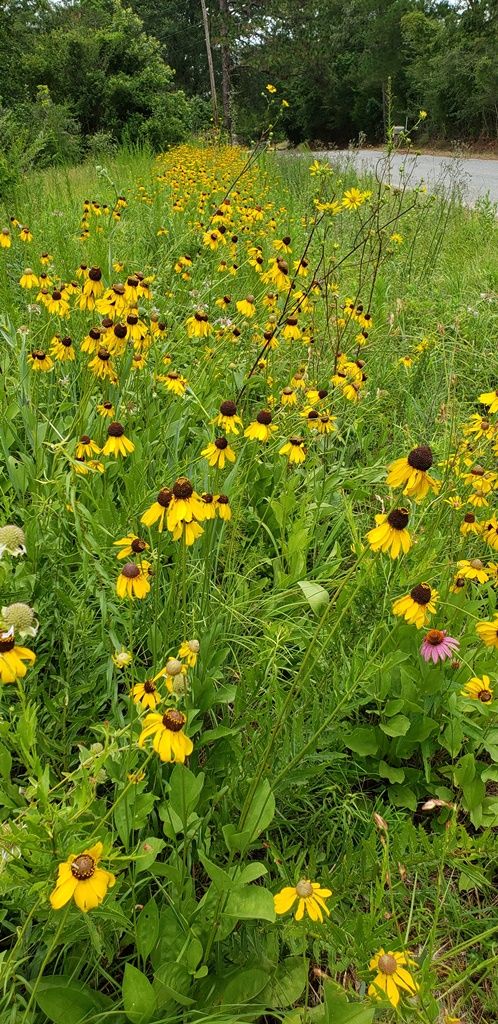
The Roadside Meadow 6/24/2019
If you have your own land with natural areas or can get permission from landowners, you can harvest your own wildflower seeds. In most states you can get fined for harvesting wildflower seeds along highway right of ways that are managed by county, city, state or federal agencies. It is also important to know the plants well enough that you can recognize them in seed. Some are more obvious than others, but you wouldn’t want to find yourself collecting seeds of undesirable weedy species. Take pictures of species that you are not familiar with that interest you to help you identify and remember them for later. It is a good idea to visit the same area starting in spring and every few weeks during the growing season, if possible, so that you can learn not only to recognize the seed heads as well as to identify and locate species of interest. This also gives you a chance to collect a variety of seed from plants that flower in each season. As your own meadow or prairie matures you can collect seed from it to increase or start a new area.
When collecting wildflower seeds, it is important that the seed are mature before you collect them. We have collected seed of Liatris or Blazingstars just a week early and ended up with zero germination, on more than one occasion. The stem that supports the seeds will generally turn brown just below the ripe seed heads. For wind borne seeds, like for Liatris, we generally expect some of the seed to start blowing away on its own before we know the seeds are mature. For seeds in pods, like legumes and milkweeds, the pods should be changing color from green to yellow or even brown and in the case of Milkweeds the pod should be starting to split open on its own. Using a pair of sharp bypass pruners you can easily cut the pods or heads off of the plant and drop them in your bag whole for later processing.
Never take more than you need and never take all of anything. Be generous and be a good steward when wild collecting seed so that these species will still be there for future generations to enjoy and wildlife to utilize. Be polite to landowners in case you someday you want to go back. As my mentors have always said, never leave more than your footprints.
It is important that your hand collected and purchased seeds be stored in such a manner that they will not develop mold or otherwise lose viability. We always use paper bags, like lunch bags, loosely filling them to about 1/4-1/3 full. It is a good idea to label your bags with the date, name, and even the collection site if you think you might want that information for later use, but this is not a requirement. You can mix and match species in your bags or collect one species at a time which can make later hand processing easier. If there is very much green material in the bags, it may be a good idea to spread that material out on newspapers in a dry area out of the wind to help prevent mold as they continue to dry out. Some collectors will collect using a large strong trash bag or durable tightly woven mesh bag and then empty it out onto a weighted down tarp to begin the drying process while they continue collecting. It can take a week or more for some material to fully dry out and fully dried seed heads also generally make processing by hand quicker and easier. Properly harvested and stored seed of most species can remain viable for a minimum of 2-3 years or more depending on the species with proper collection and storage. Seed should be kept reasonably cool and dry until you are ready to sow it. Using sealed containers will also help to prevent insect and mammal infestations.
Processing the ripened seed heads will be important prior to sowing them so that you get the most out of each seed head. Some seeds like fully ripened Blazingstars separate in one swipe of the hand down the dense spikes while the ripened cones of Rudbeckias take slightly more work. We will often process our seed heads while watching tv. Some collectors will simply take the entire mix of dried collected seed and spread and shake them as they are over the area. We have also known collectors who loose fill a large durable round trash can and then use a weed eater to help break everything down. Whatever method you choose, the more the seed heads are broken down the better coverage you will get.
As previously mentioned, you need to have your seed on hand and ready to sow in early fall. We generally plan to sow our wildflower seeds in our zone 8B meadows around the first week of October. The earlier you can get the area planted the sooner many of your winter growing and spring, summer, and fall flowering annuals, biennials, and perennials will have a chance to germinate and begin to get established and hardened off before the first killing frosts. The great majority of our native wildflowers will grow slowly all winter, often as low simple rosettes of foliage, developing the resources required for vigorous spring or summer growth and flowering.
For more in-depth information on seed collecting, including charts with when (the timing will vary to some degree depending on your climate) to collect seed of individual species, designing seed mixes, and more see the following links:
Lady Bird Johnson Wildflower Center – How to Collect and Store Seeds:
https://www.wildflower.org/learn/collect-store-seeds
Tall Grass Prairie Center – University of Northern Iowa:
https://tallgrassprairiecenter.org/technical-guides
Step 5. Preparing the Meadow or Prairie for Sowing
.jpg)
Slender Blazingstar, Liatris acidota, with Flat-topped Goldenrod, Oligoneuron nitida, in the background
You will want to assess and get ready to prepare your area well in advance of the fall sowing. Your goal is to prepare as much bare open ground so that the seeds are exposed to sunlight and have good contact with the soil’s surface. If the area is covered by dense perennial grasses or other difficult to eradicate species, it may be necessary to begin preparing the area as soon as the spring prior to your fall sowing. This may require that you use one or more applications of an herbicide, or more than one type of herbicide, to effectively eliminate and minimize potential competition from perennial weeds and grasses with your meadow’s newly emerging seedlings. You want to apply the herbicide well in advance of preparing the soil for seed sowing so that it will have time to have maximum effect before removing or tilling in the dead vegetation. Some herbicides have a long life span that could prevent germination for a year or more on treated sites so be selective when deciding which herbicide(s) to apply. Always read and follow the label and use the pesticide as directed and apply it safely.
You will want to till or disk the area to a depth of about 6-8” prior to upcoming dry periods. Turning the soil using a disk or tiller will help to uproot perennial and annual weeds and grasses and once they are on the surface the roots’ exposure to sunlight will help to kill them. Exposure to a few dry sunny days can be enough to kill even some of the toughest perennial weeds. Tilling will also help to incorporate the organic matter into the soil, improving its water holding and nutrient holding capacity, and it will give the organic material a chance to start breaking down. This will also help to aerate and loosen the soil eliminating compaction and making it easier for young roots to penetrate the soil. You can till the area 2 or more times about once every few weeks with the last preparation being completed just prior to sowing.
For very small areas, and for those of us that are still young and energetic, you can remove the existing vegetation by hand. Do not remove any more topsoil than is necessary and be sure that you get the roots of any undesirable perennial weeds to eliminate the chance of their return. Once you have the greatest percentage of the soil exposed, preferably a minimum of 90%, you can rake it smooth with a stiff metal rake (we call it a garden rake) and to lightly loosen the top layer or so of soil to about 1” deep. It is a good idea to loosen it up a couple of times, and again over a period of a couple of weeks. Rake out and remove any plant material and roots and compost them since you cannot turn them in. Lightly rake the area again the day before or just prior to sowing your seed.
Learn more about the importance of proper seedbed preparation at the links below:
A Guide to Native Plant Gardening – Lady Bird Johnson Wildflower Center:
https://www.wildflower.org/learn/guide-native-plant-gardening
USDA NRCS Plant Conservation Service Seedbed Preparation Video:
https://youtu.be/F04kscxnPm4
Step. 6 Sowing Your New Meadow or Prairie
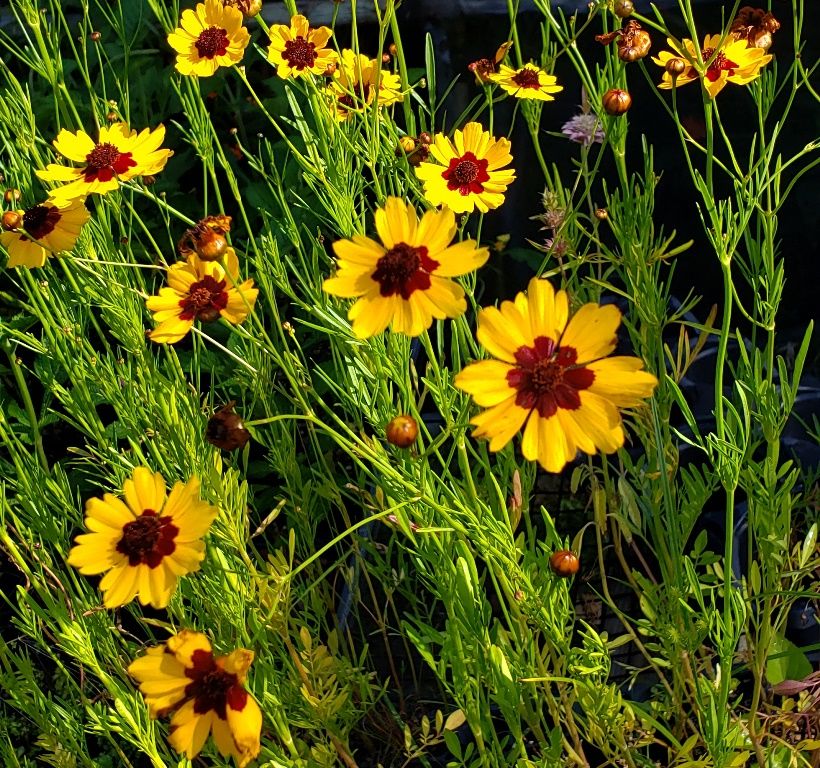
Plains Coreopsis or Golden Tickseed, Coreopsis tinctoria
Finally, the hard work is done, and you get to plant your new meadow or prairie with your collection of native seeds. There is more than one way to effectively spread your wildflower seed. For mixed seeds, unless you have a commercial spreader that can handle them, it is just about as easy to broadcast your seed by hand. Non-windborne seeds of the same size can be spread using small hand-held spreaders or walk behind spreaders to good effect. Very small seed may need to be mixed with sand to help ensure good distribution. Windborne seed, like Liatris, are typically easiest spread by hand and a light breeze will help to make easy work of it.
When you are spreading you want to make sure that you get good coverage and even distribution within reason. Spreading in a north-south direction and then crisscrossing that with an east-west pass of the same seed will help you to get even distribution. You may also choose to spread each species individually and may decide you want to use swaths of this and swaths of that here and there to add interest and to create a mass effect of some species. Hand spreading also has the benefit that when you are walking over the area your feet are firmly pressing the seeds into the soil’s surface.
Optimally, choose a day just before a good rain so that it will thoroughly water your seed in after sowing. Often, fall rains will be enough to provide this moisture, but for a small area you can use a sprinkler on an automatic hose timer to run for just long enough to keep the soil’s surface moist, but not wet or soggy for long periods, if rains are lacking. The length of time and frequency that you water is going to vary depending on your climate, precipitation, and soil type. Sandy and loamy soils will be more likely to benefit from this type of light periodic irrigation than a clay soil that holds moisture for long periods. Irrigation is not a requirement and so if you have a large area, don’t fret as mother nature will generally see to it. Where it is feasible, it can help to give your wildflower seeds the boost that they need to get started growing as early in the season as possible and thus giving them a competitive edge over any weedy species in the soil’s seedbank.
Step 7. The Waiting Game
Many wildflower and grass seeds will continue to germinate over winter, into spring and some may not germinate for 2 or more years after planting. Spring will begin to offer up flowers from early flowering annuals and biennials that germinated the previous fall. By summer and fall you should have at least seen some perennials flowering in the mix. As the meadow or prairie begins to mature with each passing season, the perennial grasses and wildflowers will begin to compete more and more with the annual and biennial species.
If you feel that there is something that your meadow is missing, you can always come back and overseed these species or add them in as plugs or transplants. Again, you will do any additional seeding in fall or after the winter mowing under most circumstances. It will be easiest to establish any plugs or transplants during late fall, winter, or even in early spring when these species are in their natural dormant state and their water demands are lowest.
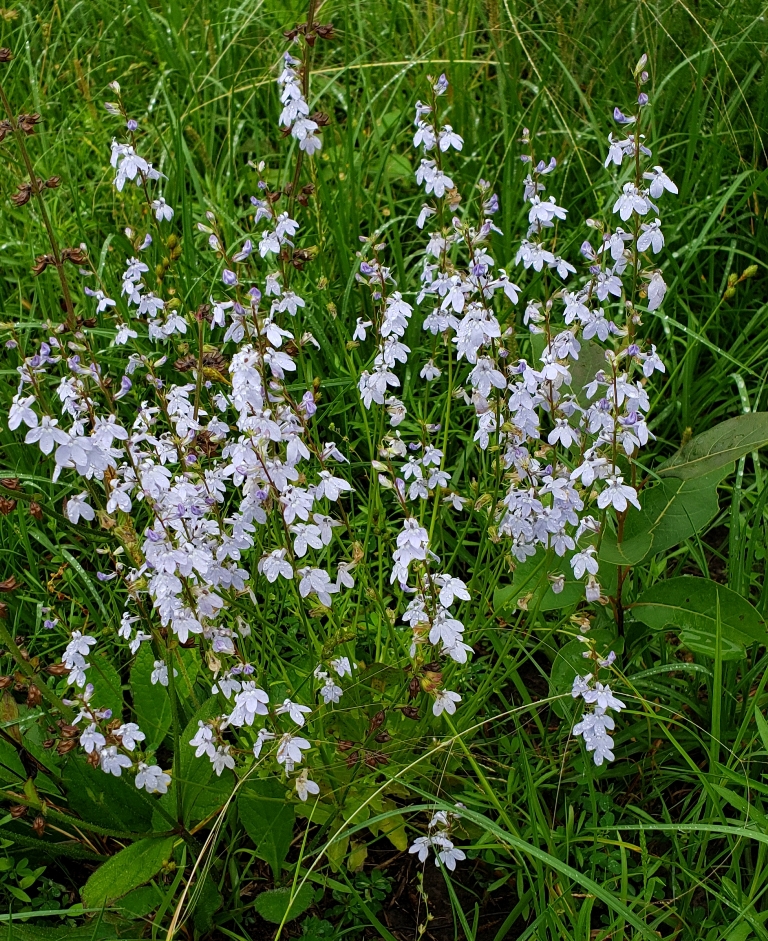
Pale Lobelia, Lobelia appendiculata – a particularly bushy specimen as this annual species is normally single or few-stemmed but the winter mowing pruned it back making a much denser plant.
Step 8. Mowing
You can use any relatively heavy-duty mower or a brush or bush-hog to mow the entire area down to about 6” high. For a narrow strip, a typical lawn mower may be able to handle it if you set it on its highest setting. You may even be able to use a weed eater with blades to do the trick in quick fashion. Whatever you use, it will need to be able to cut through any large tough stems up to about ¾” in diameter even though the great majority of species will be easier and smaller to cut. As we mentioned previously, this will help to spread and breakup ripened seed heads, spread the seed, help with seed coat thinning and nicking, prune back existing perennial species, and creating bare soil in open spaces for seed germination.
In some areas you may be able to do a controlled-burn and you can do this in place of the mowing. It must be done by qualified professionals with the knowledge, equipment, insurance, permits and licensing required by your state and local authorities. They should have developed and submitted a burn plan for approval well before they set the first fire. This is not something that you should do on your own! A wildfire could cost you and your neighbors their homes, threaten the safety of your family, and could put you in jail even though you had the best of intentions. Many factors go into determining when and how to properly do a controlled-burn and even then, under optimum conditions a controlled-burn can quickly turn into a wildfire. Mowing is without a doubt the easiest and safest option that most of us should turn to for maintaining our once-mown meadows or prairies.
Appendix A – Online Resources for Developing Your Species Lists
Cajun Prairie Habitat Restoration Society
https://www.cajunprairie.org/projects
Louisiana Native Plant Society
https://www.lnps.org/
Lady Bird Johnson Wildflower Center's Special Collections
https://www.wildflower.org/collections/
Paradise Lost? – The Coastal Prairie of Louisiana and Texas
https://www.nwrc.usgs.gov/prairie/paradise_lost.pdf
Pollinator Partnership Ecoregion Guides
https://www.pollinator.org/guides
Seed Bed Preparation Video – USDA NRCS Plant Conservation Service
https://youtu.be/F04kscxnPm4
Tall Grass Prairie Center – University of Northern Iowa
https://tallgrassprairiecenter.org/technical-guides
USDA Plants Database State Checklists
https://plants.usda.gov/dl_state.html
The Xerxes Society Regional Plant Lists for Pollinators
https://xerces.org/pollinator-conservation/plant-lists/
This is only a taste of the available online resources! An internet search can help you find numerous additional lists that have been compiled by the county extension services, universities, state native plant societies, and more.
Appendix B. Native Wildflower & Grass Species for a Once-Mown Meadow or Prairie
We started the list below with a basic species list from the Cajun or Coastal Prairie and modified it to include the 80 or so species in our Almost Eden Once-Mown Meadows. Out of curiosity and to show species range overlap, and thus the adaptability of these species, we have also included whether these species exist in the Tall Grass Prairie. We’ve also attempted to denote if a particular species tends to lean more heavily toward moist or dry conditions where applicable.
* Denotes species that may already exist and haven’t been noted or have the potential to be added to our meadows.
|
Scientific Name
|
Common Name
|
Cajun Prairie
|
Tall Grass Prairie
|
Almost Eden Meadows
|
Moist Sites
|
Dry Sites
|
|
Acacia farnesiana
|
Huisache
|
Yes
|
|
|
|
|
|
Acalypha gracilens
|
Three seeded mercury
|
Yes
|
|
*
|
|
|
|
Achillea millefolium
|
Yarrow
|
Yes
|
Yes
|
|
|
Yes
|
|
Acmella oppositifolia
|
Spot flower
|
Yes
|
|
|
|
|
|
Agalinis sp
|
False foxglove
|
Yes
|
Yes
|
Yes
|
|
|
|
Aletris aurea
|
Golden colic-root
|
Yes
|
|
Yes
|
Yes
|
|
|
Aletris farinosa
|
White colic-root
|
Yes
|
|
|
Yes
|
|
|
Allium canadense var canadense
|
Meadow garlic
|
Yes
|
Yes
|
*
|
Yes
|
Yes
|
|
Alophia drummondii
|
Pinewoods Lily
|
|
|
*
|
|
Yes
|
|
Amsonia tabernaemontana
|
Eastern blue-star
|
Yes
|
|
|
Yes
|
|
|
Andropogon gerardii
|
Big bluestem
|
Yes
|
Yes
|
Yes
|
|
|
|
Andropogon ternarius
|
Split-beard bluestem
|
Yes
|
|
*
|
|
Yes
|
|
Andropoogon glomeratus
|
Bushy bluestem
|
Yes
|
|
Yes
|
Yes
|
|
|
Anemone berlandieri
|
Ten-petal anemone
|
Yes
|
|
|
|
|
|
Anthaenantia rufa
|
Purple silky scale
|
Yes
|
|
*
|
|
|
|
Arnoglossum ovatum
|
Indian plantain
|
Yes
|
|
|
Yes
|
|
|
Asclepias amplexicaulis
|
Clasping Milkweed
|
|
|
*
|
|
Yes
|
|
Asclepias lanceolata
|
Red milkweed
|
Yes
|
|
|
Yes
|
|
|
Asclepias longifolia
|
Long-leaf milkweed
|
Yes
|
|
|
Yes
|
|
|
Asclepias obovata
|
Pineland milkweed
|
Yes
|
|
*
|
|
Yes
|
|
Asclepias perennis
|
White Swamp Milkweed
|
Yes
|
|
|
Yes
|
|
|
Asclepias tuberosa
|
Butterfly-weed
|
Yes
|
Yes
|
Yes
|
|
Yes
|
|
Asclepias verticillata
|
Whorled milkweed
|
Yes
|
Yes
|
*
|
|
Yes
|
|
Asclepias viridiflora
|
Green milkweed
|
Yes
|
Yes
|
|
Yes
|
|
|
Asclepias viridis
|
Green milkweed
|
|
|
*
|
|
|
|
Aster ericoides
|
Heath aster
|
Yes
|
|
*
|
|
|
|
Aster patens
|
Late purple aster
|
Yes
|
|
*
|
|
|
|
Aster praealtus
|
Willowleaf aster
|
Yes
|
Yes
|
*
|
|
|
|
Aster sericeus
|
Western silver aster
|
Yes
|
Yes
|
*
|
|
|
|
Baptisia alba
|
White wild-indigo
|
Yes
|
Yes
|
*
|
|
|
|
Baptisia bracteata var. leucophaea
|
Nodding wild-indigo
|
Yes
|
Yes
|
Yes
|
|
|
|
Baptisia sphaerocarpa
|
Yellow wild indigo
|
Yes
|
|
Yes
|
|
|
|
Berlandiera betonicifolia
|
Texas Green-eyes
|
|
|
*
|
|
Yes
|
|
Bigelowia virgata
|
Rayless goldenrod
|
Yes
|
|
|
|
|
|
Boltonia asteroides
|
White doll's daisy
|
|
|
*
|
Yes
|
|
|
Boltonia diffusa
|
Doll’s daisy
|
Yes
|
|
Yes
|
|
|
|
Bothriochloa laguroides
|
Silver bluestem
|
Yes
|
|
|
|
|
|
Buchnera americana
|
Florida bluehearts
|
Yes
|
|
Yes
|
|
|
|
Callirhoe papaver
|
Winecups
|
Yes
|
|
*
|
|
*
|
|
Calopogon oklahomensis
|
Bearded grass-pink
|
Yes
|
|
|
|
|
|
Castilleja indivisa
|
Texas paintbrush
|
Yes
|
|
|
|
Yes
|
|
Ceanothus americanus
|
New Jersey tea
|
Yes
|
Yes
|
*
|
|
Yes
|
|
Centaurium breviflorum
|
Centuary
|
Yes
|
|
|
|
|
|
Centrosema virginianum
|
Spurred butterfly pea
|
Yes
|
|
Yes
|
|
Yes
|
|
Chamaecrista fasciculata
|
Partridge pea
|
Yes
|
Yes
|
Yes
|
|
Yes
|
|
Chamaecrista nictitans
|
Sensitive partridge pea
|
|
Yes
|
|
Yes
|
|
Chrysopsis mariana
|
Maryland golden-aster
|
Yes
|
|
Yes
|
|
Yes
|
|
Chrysopsis pilosa
|
Hairy golden aster
|
Yes
|
|
Yes
|
|
Yes
|
|
Cicuta maculata
|
Water hemlock
|
Yes
|
Yes
|
|
Yes
|
|
|
Cirsium horridulum
|
Yellow thistle
|
|
|
Yes
|
|
Yes
|
|
Cirsium texanum
|
Texas thistle
|
Yes
|
|
*
|
|
Yes
|
|
Claytonia virginica
|
Springbeauty
|
Yes
|
|
*
|
|
|
|
Clematis crispa
|
Blue jasmine
|
Yes
|
|
|
Yes
|
|
|
Commelina virginica
|
Virginia dayflower
|
Yes
|
|
*
|
|
|
|
Cooperia drummondii
|
Drummond rain lily
|
Yes
|
|
|
|
|
|
Coreopsis pubescens
|
Star tickseed
|
|
|
Yes
|
|
Yes
|
|
Coreopsis lanceolata
|
Lanceleaf tickseed
|
Yes
|
|
Yes
|
|
Yes
|
|
Coreopsis tinctoria
|
Plains coreopsis
|
Yes
|
|
Yes
|
|
|
|
Coreopsis tripteris
|
Tall tickseed
|
Yes
|
Yes
|
|
|
|
|
Crinum americanum
|
Swamp lily
|
Yes
|
|
|
Yes
|
|
|
Crotalaria sagittalis
|
Arrowleaf rattlebox
|
Yes
|
|
*
|
|
|
|
Croton capitatus
|
Woolly croton
|
Yes
|
|
Yes
|
|
Yes
|
|
Ctenium aromaticum
|
Toothache grass
|
Yes
|
|
|
Yes
|
|
|
Cynanchum angustifolium
|
Narrowleaf sandvine
|
Yes
|
|
|
|
|
|
Dalea purpurea
|
Prairie clover
|
Yes
|
|
|
|
|
|
Dalea candida
|
White prairieclover
|
Yes
|
Yes
|
|
|
|
|
Delphinium carolinianum
|
Carolina larkspur
|
Yes
|
|
*
|
|
Yes
|
|
Desmanthus illinoensis
|
Illinois bundleflower
|
Yes
|
Yes
|
*
|
|
|
|
Desmodium ciliare
|
Hairy ticktrefoil
|
Yes
|
|
*
|
|
|
|
Desmodium sessilifolium
|
Sessile-leaf ticktrefoil
|
Yes
|
|
*
|
|
|
|
Diodia virginiana
|
Poorjoe
|
Yes
|
|
*
|
Yes
|
|
|
Echinacea pallida
|
Pale coneflower
|
Yes
|
Yes
|
*
|
|
|
|
Echinacea purpurea
|
Purple coneflower
|
|
|
Yes
|
|
|
|
Echinacea sanguinea
|
Sanguin coneflower
|
|
|
Yes
|
|
Yes
|
|
Erigeron strigosa
|
Daisy Fleabane
|
|
|
Yes
|
|
|
|
Eryngium hookeri
|
Hooker’s eryngo
|
Yes
|
|
|
Yes
|
|
|
Eryngium integrifolium
|
Blueflower eryngo
|
Yes
|
|
|
Yes
|
|
|
Eryngium yuccifolium
|
Button snakeroot
|
Yes
|
Yes
|
Yes
|
|
|
|
Erythrina herbacea
|
Coralbean
|
Yes
|
|
*
|
|
Yes
|
|
Eupatorium coelestinum
|
Blue-mist flower
|
Yes
|
|
*
|
|
|
|
Eupatorium hyssopifolium
|
Narrowleaf boneset
|
Yes
|
|
|
|
|
|
Eupatorium ivifolium
|
Ivyleaf boneset
|
Yes
|
|
|
|
|
|
Eupatorium coelestinum
|
Blue-mist flower
|
Yes
|
|
*
|
|
|
|
Eupatorium perfoliatum
|
Common boneset
|
Yes
|
|
Yes
|
|
|
|
Euphorbia bicolor
|
Snow-on-the-prairie
|
Yes
|
|
|
|
|
|
Euphorbia corollata
|
Flowering spurge
|
Yes
|
Yes
|
Yes
|
|
Yes
|
|
Euthamia tenuifolia
|
Flat-topped goldenrod
|
Yes
|
|
|
Yes
|
|
|
Evolvulus sericeus
|
Silky evolvulus
|
Yes
|
|
|
|
|
|
Gaillardia aestivalis
|
Yellow Indian-blanket
|
Yes
|
|
Yes
|
|
Yes
|
|
Gaillardia pulchella
|
Indian blanket
|
|
|
Yes
|
|
Yes
|
|
Galactia volubilis
|
Downy milkpea
|
Yes
|
|
|
|
|
|
Gaura lindheimeri
|
Large-flowered beeblossom
|
Yes
|
|
Yes
|
|
Yes
|
|
Habenaria nivea
|
Snowy orchid
|
Yes
|
|
|
|
|
|
Hedyotis nigricans
|
Prairie bluets
|
Yes
|
|
|
|
|
|
Helenium drummondii
|
Fringed sneezeweed
|
Yes
|
|
|
|
|
|
Helenium flexuosum
|
Purple-head sneezeweed
|
Yes
|
|
*
|
|
|
|
Helianthus angustifolius
|
Narrowleaf sunflower
|
Yes
|
|
Yes
|
|
Yes
|
|
Helianthus annuus
|
Annual sunflower
|
Yes
|
|
*
|
|
|
|
Helianthus maximiliani
|
Maximilian sunflower
|
Yes
|
|
*
|
|
|
|
Helianthus mollis
|
Ashy sunflower
|
Yes
|
|
Yes
|
|
Yes
|
|
Helianthus simulans
|
Muck sunflower
|
Yes
|
|
Yes
|
|
Yes
|
|
Herbertia lahue ssp caerula
|
Prairienymph
|
Yes
|
|
*
|
|
Yes
|
|
Heterotheca subaxillaris
|
Camphorweed
|
|
|
Yes
|
|
Yes
|
|
Hibiscus coccineus
|
Texas star hibiscus
|
Yes
|
|
|
Yes
|
|
|
Hibiscus lasiocarpus
|
Wooly rose-mallow
|
Yes
|
|
|
Yes
|
|
|
Hydrocotyle sp
|
Pennywort
|
Yes
|
|
|
|
|
|
Hydrolea ovata
|
Blue waterleaf
|
Yes
|
|
|
Yes
|
|
|
Hymenocallis caroliniana
|
Spider lily
|
Yes
|
|
|
Yes
|
|
|
Hypericum cistifolium
|
Roundpod St John’s Wort
|
Yes
|
|
|
|
|
|
Hypericum drummondii
|
Nits and lice
|
Yes
|
|
|
|
|
|
Hypericum stans
|
St. Peter’s-wort
|
Yes
|
|
|
|
|
|
Hypoxis hirsuta
|
Eastern yellow stargrass
|
Yes
|
Yes
|
Yes
|
|
Yes
|
|
Hyptis alata
|
Cluster bushmint
|
Yes
|
|
|
Yes
|
|
|
Ipomoea sagittata
|
Saltmarsh morning-glory
|
Yes
|
|
|
|
|
|
Iris fulva
|
Red iris
|
Yes
|
|
|
Yes
|
|
|
Iris virginica
|
Southern blueflag
|
Yes
|
|
|
Yes
|
|
|
Krameria lanceolata
|
Sandbur
|
Yes
|
|
|
|
|
|
Lechea mucronata
|
Hairy pinweed
|
|
|
Yes
|
|
Yes
|
|
Lespedeza capitata
|
Round-head bushclover
|
Yes
|
Yes
|
|
|
|
|
Liatris acidota
|
Slender gayfeather
|
Yes
|
|
Yes
|
|
Yes
|
|
Liatris aspera
|
Tall blazingstar
|
|
|
Yes
|
|
|
|
Liatris elegans
|
White bract blazingstar
|
Yes
|
|
Yes
|
|
Yes
|
|
Liatris pycnostachya
|
Kansas gayfeather
|
Yes
|
Yes
|
Yes
|
Yes
|
|
|
Liatris squarrosa
|
Scaly gayfeather
|
Yes
|
|
Yes
|
|
Yes
|
|
Limnoscaiadium pinnatum
|
Tansy dogshade
|
Yes
|
|
|
|
|
|
Linaria canadensis
|
Old field toadflax
|
Yes
|
|
Yes
|
|
|
|
Linum medium
|
Stiff yellow flax
|
Yes
|
|
*
|
|
|
|
Lobelia appendiculata
|
Pale lobelia
|
Yes
|
|
Yes
|
|
Yes
|
|
Lobelia puberula
|
Downy lobelia
|
Yes
|
|
Yes
|
|
Yes
|
|
Ludwigia linearis
|
Narrowleaf seedbox
|
Yes
|
|
|
|
|
|
Lythrum alatum var
|
Lanceleaf loosestrife
|
Yes
|
|
|
|
|
|
Malvaviscus arboreus
|
Turks’ cap
|
Yes
|
|
*
|
|
Yes
|
|
Manfreda virginica
|
American aloe
|
Yes
|
|
*
|
|
Yes
|
|
Mikania scandens
|
Climbing hemp vine
|
Yes
|
|
|
|
|
|
Mimosa microphylla
|
Littleleaf Sensitive Brier
|
Yes
|
|
Yes
|
|
Yes
|
|
Monarda citriodora
|
Lemon beebalm
|
Yes
|
|
Yes
|
|
Yes
|
|
Monarda lindheimeri
|
Lindheimer’s beebalm
|
Yes
|
|
|
|
|
|
Monarda fistulosa
|
Beebalm
|
|
|
Yes
|
|
Yes
|
|
Monarda punctata
|
Spotted beebalm
|
Yes
|
|
Yes
|
|
Yes
|
|
Muhlenbergia capillaris
|
Gulf coast muhly
|
Yes
|
|
*
|
|
Yes
|
|
Nassella leucotricha
|
Texas wintergrass
|
Yes
|
|
|
|
|
|
Neptunia lutea
|
Yellowpuff
|
Yes
|
|
|
Yes
|
|
|
Nothoscardum bivalve
|
False garlic
|
Yes
|
|
Yes
|
|
Yes
|
|
Oenothera biennis
|
Common evening primrose
|
Yes
|
|
Yes
|
|
|
|
Oenothera speciosa
|
Showy evening-primrose
|
Yes
|
|
Yes
|
|
Yes
|
|
Oligoneuron nitida
|
Shiny goldenrod
|
Yes
|
|
Yes
|
|
Yes
|
|
Opuntia lindheimeri
|
Texas prickly pear
|
Yes
|
|
|
|
Yes
|
|
Opuntia macrorhiza
|
Grassland prickly pear
|
Yes
|
|
|
|
Yes
|
|
Orbexilum pedunculatum
|
Sampson’s snakeroot
|
Yes
|
|
|
|
|
|
Orbexilum simplex
|
Single-stem scurfpea
|
Yes
|
|
|
|
|
|
Panicum hians
|
Gaping panicum
|
Yes
|
|
|
|
|
|
Panicum virgatum
|
Switchgrass
|
Yes
|
Yes
|
*
|
Yes
|
|
|
Paspalum floridanum
|
Florida paspalum
|
Yes
|
|
*
|
|
Yes
|
|
Paspalum plicatulum
|
Brown-seed Pasaplum
|
Yes
|
|
Yes
|
|
Yes
|
|
Paspalum setaceum
|
Thin paspalum
|
Yes
|
|
|
|
|
|
Passiflora incarnata
|
Maypop
|
Yes
|
|
*
|
|
Yes
|
|
Pedicularis canadensis
|
Canada lousewort
|
Yes
|
Yes
|
*
|
|
|
|
Penstemon digitalis
|
Foxglove beardtongue
|
|
|
*
|
Yes |
|
|
Penstemon laxiflorus
|
Muskogee beardtongue
|
Yes
|
|
Yes
|
|
Yes
|
|
Penstemon tenuis
|
Sharpsepal beardtongue
|
Yes
|
|
Yes
|
Yes
|
|
|
Penstemon tubiflorus
|
Whitewand beardtongue
|
|
|
* |
Yes
|
|
Phlox drummondii
|
Drummond Phlox
|
|
|
|
|
Yes
|
|
Phlox pilosa
|
Prairie phlox
|
Yes
|
Yes
|
Yes
|
|
Yes
|
|
Physostegia digitalis
|
Finger False Dragonhead
|
|
Yes
|
|
Yes
|
|
Physostegia intermedia
|
Slender false dragonhead
|
Yes
|
|
|
Yes
|
|
|
Physostegia virginiana
|
False Dragonhead
|
|
|
*
|
Yes
|
|
|
Pityopsis graminifolia
|
Silkgrass
|
Yes
|
|
Yes
|
|
Yes
|
|
Pluchea foetida
|
Marsh fleabane
|
Yes
|
|
|
Yes
|
|
|
Polygala cruciata
|
Drumheads
|
Yes
|
|
|
|
|
|
Polygala incarnata
|
Pink milkwort
|
Yes
|
|
*
|
|
Yes
|
|
Polygala leptocaulis
|
Swamp milkwort
|
Yes
|
|
|
|
|
|
Polygala mariana
|
Maryland milkwort
|
Yes
|
|
|
|
|
|
Polygala nana
|
Candyroot
|
Yes
|
|
*
|
|
Yes
|
|
Polytaenia nuttallii
|
Prairie parsley
|
Yes
|
|
|
|
|
|
Prunella vulgaris
|
Selfheal
|
|
|
Yes
|
|
Yes
|
|
Pseudognaphalium obtusifolium
|
Rabbit tabacco
|
Yes
|
|
Yes
|
|
Yes
|
|
Pteroglassaspis ecristata
|
Wild coco
|
Yes
|
|
|
|
|
|
Pycnanthemum albescens
|
White mountainmint
|
Yes
|
|
Yes
|
|
Yes
|
|
Pycnanthemum muticum
|
Clustered mountain-mint
|
Yes
|
|
*
|
|
|
|
Pycnanthemum tenuifolium
|
Slender mountain-mint
|
Yes
|
Yes
|
Yes
|
Yes
|
|
|
Pyrrhopappus carolinianus
|
False dandelion
|
Yes
|
|
Yes
|
|
Yes
|
|
Ranunculus fascicularis
|
Prairie buttercup
|
Yes
|
|
*
|
|
Yes
|
|
Ratibida columnifera
|
Upright prairie coneflower
|
|
|
Yes
|
|
Yes
|
|
Ratibida pinnata
|
Prairie coneflower
|
Yes
|
Yes
|
*
|
|
|
|
Rhexia lutea
|
Yellow meadowbeauty
|
Yes
|
|
|
Yes
|
|
|
Rhexia mariana
|
Maryland meadow beauty
|
Yes
|
|
Yes
|
Yes
|
|
|
Rhynchospora caduca
|
Falling beakrush
|
Yes
|
|
|
|
|
|
Rhynchospora colorata
|
White-top sedge
|
Yes
|
|
|
Yes
|
|
|
Rudbeckia grandiflora
|
Tall coneflower
|
Yes
|
|
Yes
|
Yes
|
|
|
Rudbeckia hirta
|
Black-eyed susan
|
Yes
|
Yes
|
Yes
|
|
Yes
|
|
Rudbeckia maxima
|
Giant Coneflower
|
|
|
Yes
|
Yes
|
|
|
Rudbeckia subtomentosa
|
Sweet Coneflower
|
|
|
*
|
Yes
|
|
|
Rudbeckia texana
|
Texas coneflower
|
Yes
|
|
Yes
|
Yes
|
|
|
Ruellia humilis
|
Prairie petunia
|
Yes
|
|
Yes
|
|
Yes
|
|
Sabatia campestris
|
Prairie rose-gentian
|
Yes
|
|
|
Yes
|
|
|
Salvia azurea
|
Blue sage
|
Yes
|
|
Yes
|
|
|
|
Schizachyrium scoparium
|
Little bluestem
|
Yes
|
Yes
|
Yes
|
|
Yes
|
|
Scutellaria integrifolia
|
Rough skullcap
|
Yes
|
|
*
|
|
|
|
Scutellaria parvula
|
Small skullcap
|
Yes
|
|
|
|
|
|
Senecio tomentosus
|
Woolly groundsel
|
Yes
|
|
*
|
|
|
|
Silene subciliata
|
Louisiana catchfly
|
|
|
*
|
|
|
|
Silphium asteriscus
|
Starry Rosinweed
|
Yes
|
|
Yes
|
|
|
|
Silphium gracile
|
Rosinweed
|
Yes
|
|
Yes
|
|
Yes
|
|
Silphium laciniatum
|
Compass plant
|
Yes
|
|
Yes
|
|
|
|
Sisyrinchium atlanticum
|
Eastern blue-eyed-grass
|
Yes
|
|
*
|
|
|
|
Solanum dimidiatum
|
Western horsenettle
|
Yes
|
|
|
|
|
|
Solanum elaeagnifolium
|
Silverleaf nightshade
|
Yes
|
|
|
|
Yes
|
|
Solidago canadensis
|
Canadian goldenrod
|
Yes
|
|
Yes
|
|
Yes
|
|
Solidago odora
|
Sweet goldenrod
|
Yes
|
|
Yes
|
|
Yes
|
|
Solidago rugosa
|
Wrinkled-leaf goldenrod
|
Yes
|
|
Yes
|
|
Yes
|
|
Solidago sempervirens
|
Seaside goldenrod
|
Yes
|
|
|
Yes
|
|
|
Sorghastrum elliotii
|
Slender indiangrass
|
|
|
Yes
|
|
Yes
|
|
Sorghastrum nutans
|
Indiangrass
|
Yes
|
Yes
|
Yes
|
|
|
|
Spartina spartinae
|
Gulf cordgrass
|
Yes
|
|
|
Yes
|
|
|
Spiranthes vernalis
|
Spring ladies’-tresses
|
Yes
|
|
|
|
|
|
Sporobolus junceus
|
Pinewoods dropseed
|
Yes
|
|
Yes
|
|
Yes
|
|
Strophostyles umbellata
|
Pink wildbean
|
Yes
|
|
Yes
|
|
|
|
Stylisma aquatica
|
Water southern morning-glory
|
Yes
|
|
|
Yes
|
|
|
Stylosanthes biflora
|
Sidebeak pencil-flower
|
Yes
|
|
Yes
|
|
Yes
|
|
Styrax Americana
|
American snowball
|
Yes
|
|
|
Yes
|
|
|
Tephrosia virginiana
|
Goat's Rue
|
|
|
|
|
Yes
|
|
Tephrosia onobrychoides
|
Multibloom-hoarypea
|
Yes
|
|
Yes
|
|
Yes
|
|
Teucrium canadense
|
American germander
|
Yes
|
|
|
|
|
|
Tradescantia hirsutiflora
|
Hairy spiderwort
|
Yes
|
|
*
|
|
Yes
|
|
Tradescantia ohioensis
|
Ohio spiderwort
|
Yes
|
|
*
|
|
Yes
|
|
Tragia betonicifolia
|
Betonyleaf noseburn
|
Yes
|
|
*
|
|
Yes
|
|
Tridanis perfoliata
|
Venus’ looking glass
|
Yes
|
|
Yes
|
|
Yes
|
|
Tridens strictus
|
Longspike tridens
|
Yes
|
|
|
|
Yes
|
|
Tripsacum dactyloides
|
Eastern gamagrass
|
Yes
|
|
Yes
|
|
|
|
Verbena halei
|
Texas vervain
|
Yes
|
|
Yes
|
|
Yes
|
|
Vernonia gigantea
|
Tall ironweed
|
Yes
|
|
|
Yes
|
|
|
Vernonia missurica
|
Missouri ironweed
|
|
|
* |
|
|
|
Vernonia texana
|
Texas ironweed
|
Yes
|
|
Yes
|
|
Yes
|
|
Vicia ludoviciana
|
Louisiana vetch
|
Yes
|
|
*
|
|
|
|
Viola sagittata
|
Arrow-leaf violet
|
Yes
|
|
|
|
|
|
Xyris laxiflora
|
Yellow-eyed-grass
|
Yes
|
|
|
|
Yes
|
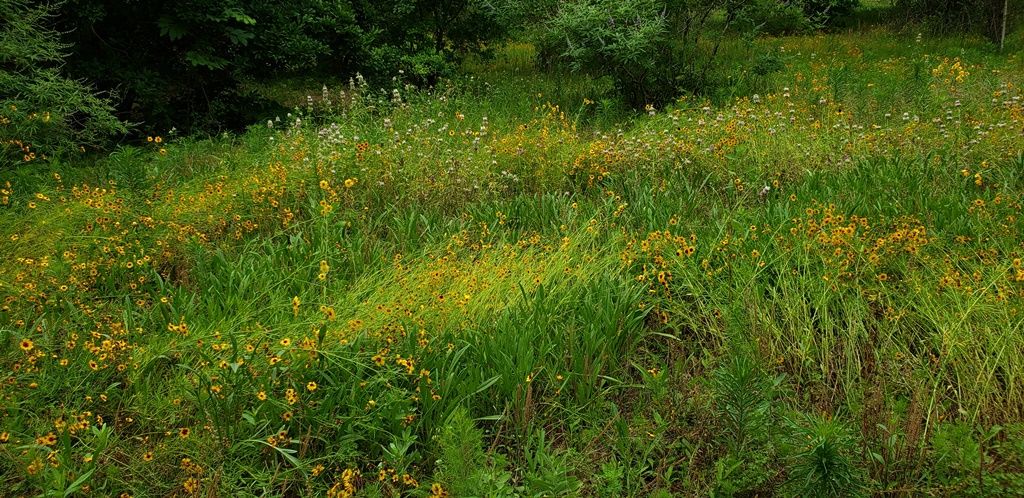
Bonnie's Butterfly Meadow 5-30-2019 - planted in the fall of 2018 (Click here for a full size image)
Acknowledgements & Accolades – A couple of special people and projects deserve special recognition for their exceptional contributions to the world of native plants in our region and for helping to inspire our own meadows
Dr. Charles M. Allen – a retired professor, author, and botanist who has shared so much with so many. He has spent his life studying, writing, and teaching about the native plant species of our region. He has also been a major driving force in the development and completion of the Eunice and Duralde Cajun Prairie restoration projects. To learn when the next native plant classes are, read his many articles on native plant species, or to purchase Dr. Allen’s books visit: https://www.allenacresbandb.com/booksandclasses
Marc Pastorek of Meadow Makers, Inc. – an entrepreneur with a unique specialty in our region and in-depth knowledge about native meadow and prairie species. He has spent his life building, establishing, and maintaining meadows, prairies, and naturalistic landscapes from the ground up as well as sharing that knowledge through tours, speaking engagements, writing, and blogging. Marc has also been a big part of establishing and restoring the Eunice and Duralde Cajun Prairie projects. Learn more or follow Marc’s blog at: https://marcpastorek.com/
An Inspiring Road Trip Anyone?
Visit the Eunice Cajun Prairie in action in Eunice, Louisiana. This restored prairie set in the middle of a city is a prime example of a high-quality prairie that is filled with flowers, pollinators, birds and other cute critters throughout the growing season. Even if you don’t develop your own prairie or meadow it is worth a visit just to experience what this amazing ecosystem has to offer. See how you can contribute and learn more by joining the Cajun Prairie Habitat Preservation Society who maintain and oversee the Eunice and Duralde Prairies. Learn more at: https://www.cajunprairie.org/projects
We hope this helps to get you started on your way to developing your own meadow or prairie installation!
Thank You & Good Growing,
Jeff McMillian & the Crew at Almost Eden
![]()

